(Strand)om Stories: X-Men Origins: Firestar Review
Middling issues serve as bookends to a well-plotted, character-driven limited series which defines this volume's titular hero
—by Nathan on July 23, 2025—
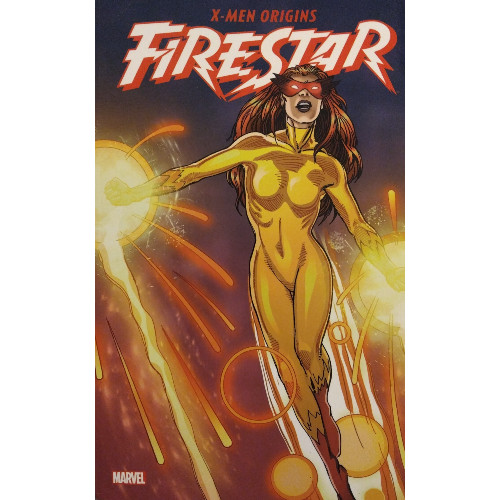
Fairly recently, I reviewed a collection of issues featuring a solid 90s Captain America arc, as the First Avenger had played a role in Spider-Man's 1993 crossover event "Maximum Carnage." But the man with the red-white-and blue vibranium shield wasn't the only merry Marvel hero to help beat back Carnage. Among a tale awash with anti-heroes came a more spirited character with the symbiote-scalding ability of pyrokinesis: Angelica Jones, the mutant known as "Firestar."
While reading "Maximum Carnage," I recalled I had picked up a volume collecting several of Angelica's original appearances a few years earlier, not to necessarily tie in to "Carnage," but because I was on a bit an X-Men hot streak, reviewing an X-Factor volume here, an early X-Men Epic Collection there. The momentum faded after a time, and I never got around to this volume. Seeing as how Firestar played somewhat of a prominent role in "Maximum Carnage"–and I'd say nearly killing Cletus Kasady's "other" is pretty prominent!–I decided to dust-off this long-neglected volume and give it a shot.
For the uninitiated, Firestar actually debuted off-panel, in 1981's Spider-Man and His Amazing Friends cartoon. Originally intending to use the Human Torch, the showrunners ran into legal issues over the flame-brained Fantastic Four member, deciding to create an original character instead and teaming her with Spidey and Iceman. Angelica outlived the show, and to this day, can be found popping up in comics, sometimes on her own, sometimes with the New Warriors. She's not a character I know much about, but I'm willing to grab some sunscreen and see how this volume gives insight into Angelica and her alter ego.
X-Men Origins: Firestar
Writers: Dennis Marks, Chris Claremont, Tom DeFalco, Marie Jevins, Marcus McLaurin, and Sean McKeever
Pencilers: Dan Spiegle, John Romita Jr., Mary Wilshire, Dwayne Turner, Pat Olliffe, Casey Jones, Kano, Nick Dragotta, and Chris Giarrusso
Inkers: Vince Coletta, Dan Green, Steve Leialoha, Bob Wiacek, Jose Marzan Jr., Chris Ivy, Livesay, Vince Russell, Kano, Alvaro Lopex, Nick Dragotta, and Chris Giarrusso
Colorists: Bob Sharen, Glynis Oliver, Diana Graziunas, Marcus McLaurin, Lee Loughridge, and Chris Giarrusso
Letterers: Jim Novak, Tom Orzechowski, Lois Buhalis, Rick Parker, Artmonkeys' Melanie Olsen, Dave Sharpe, Diana Albers, and Chris Giarrusso
Issues Collected: Spider-Man and His Amazing Friends #1, Uncanny X-Men #193, Firestar #1-4, Spider-Man Family: Amazing Friends, and material from Marvel Comics Presents #182-187
Volume Publication Date: May 2017
Issue Publication Dates: December 1981, May 1985, May 1986-June 1986, August 1991-October 1991, October 2006
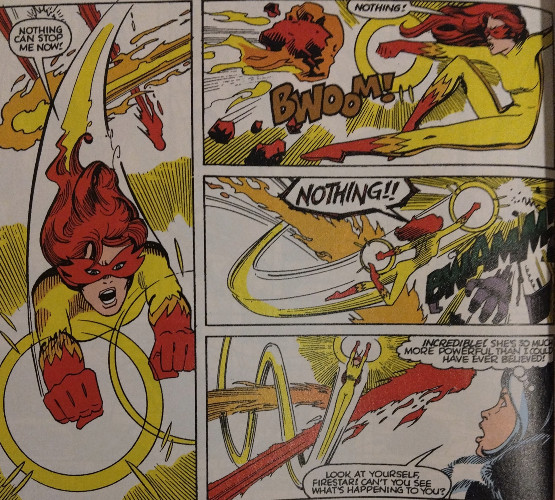
I know nothing about Spider-Man and His Amazing Friends, so I'm assuming that the show and its original character must have been popular enough among comic readers to warrant a one-shot as well as Angelica Jones' continual appearance in the Marvel Universe. Like later characters such as Harley Quinn, Phil Colson, Terry McGuiness, and X-23, Angelica needed to infiltrate the Marvel Universe, and we can thank the first few issues in this volume for giving her that push.
I'll be upfront: the Spider-Man and His Amazing Friends one-shot is probably the weakest issue in this entire volume. Its cultural significance has some solidity to it, and it has historical importance to the volume's title character, marking her debut in Marvel comics (though, I'll note, not the main Marvel Universe). The narrative itself is relatively simple, tethered to the cliche of having Peter Parker dip out of a school function to fight the Green Goblin as Spider-Man, paired with teenage buddies Firestar and Iceman. The action is alright, and there are some neat nods to general Marvel continuity (such as references to Medusa and Captain America and the plot centering on Norman Osborn's amnesia, lifted from the Stan Lee days of Spidey comics) but also some bizarre concepts, like the Goblin's main plan to turn New Yorkers into goblin lookalikes. Reading the issue, I had to remember it was a tie-in to a children's cartoon and not expect too much from the plot. It's fun for what is, an age-appropriate, non-canonical romp, but it's pretty basic.
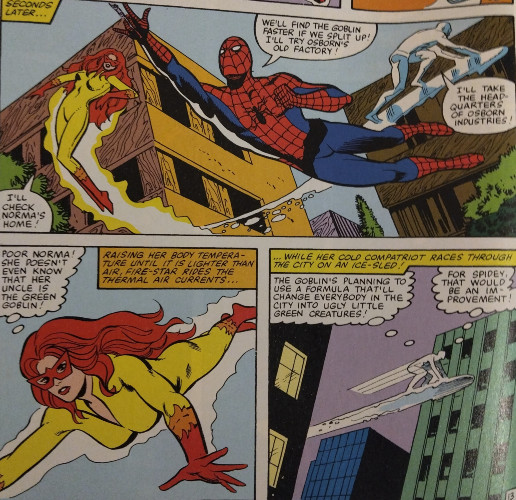
Chris Claremont and Tom DeFalco handle our red-headed hero with more complexity, introducing her to the Marvel Universe proper in an Uncanny X-Men issue and then her own four-issue limited series. DeFalco deserves recognition for fleshing out Angelica's background specifically in that series, working to create a fairly well-rounded character. Firestar does seem like yet another attempt by Marvel to catch lightning in a bottle, finding the right combination of "teenager," "tragic backstory," and "superpowers" that made Spider-Man such a whopping success. Other attempts, such as Speedball and Darkhawk, have stuck around for a while, but not to the same level of pop culture acclaim. DeFalco tries something similar here, and though Firestar is nowhere near the household name Spidey is, his efforts work in conceiving an interesting character.
It's Claremont who plants the idea that Firestar is, rather innocently, a pawn in a larger scheme involving the White Queen and her Hellions, and DeFalco uses that basis to craft his own series. He does add a handful of tried-and-true elements to Angelica's past–her mother has passed away, she's bullied at a new school–but then brings her into the X-Men side of things, and this is where the character shines, both literally and figuratively. DeFalco drills down to Angelica's core, that she's an adolescent girl with powers she can't control who just wants to be a normal high schooler and do normal high school activities like attend formals and make friends. You get scenes of Angelica training under Emma Frost's tutelage balanced with a sequence where she dances with Cannonball at a high school event. It's that interplay between the human and superhuman sides of herself that allow the reader to feel empathy, even if none of these aspects are new or original.
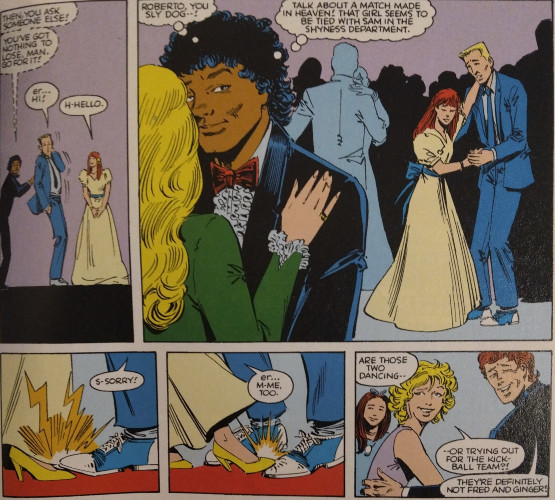
When Angelica begins attending the White Queen's version of Xavier's School for Gifted Youngsters, I found myself caught up in the recurring use of Angelica's innocence and naivety as she's manipulated by Emma Frost. DeFalco does allow Firestar a good transition from an obedient little soldier to a reluctant superhero, paralleling her change from a scared young girl to a strong-willed adolescent. Frost's techniques and fear-mongering felt adequately villainous, including one genuinely horrible scene where she makes Angelica believe herself responsible for a terrible accident. When Angelica becomes more confrontational, all the tension built up across the series breaks in a great climactic throwdown. I was a little concerned Firestar would remain naive far longer than was believable, but I found DeFalco challenged her across the series.
None of the other stories quite reach the same level of development that DeFalco includes, and there's a sense they don't necessarily need to. Angelica has made her choice and become a costumed superhero, and now stories can deal with that aspect of her. A multi-part Marvel Comics Presents narrative published in some of the same issues as Barry Windsor-Smith's "Weapon X" epic feels like a sequel of sorts to DeFalco's series and though these present a new conflict for Angelica, they fall under the same "villain manipulates Firestar to do their bidding" banner. With Firestar having already faced a similar threat in her limited series, I found the same shtick less believable in this narrative. Claremont, providing the groundwork in the X-Men issues DeFalco builds off of, does pull off a Firestar in the midst of ethical deliberations, but his narrative is more focused on the X-Men as a whole. It's a fun issue, with great John Romita Jr. art, but it's just a stepping stone to reach the work DeFalco does.
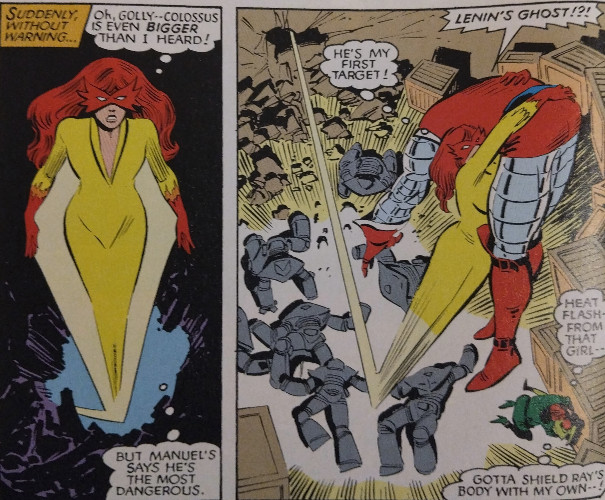
You also get a couple more recent (at least, compared to the 80s) appearances that play into the "Amazing Friends" bit, just a couple more modern tales featuring Spidey and Iceman as well as Angelica. Sean McKeever, Pat Olliffe, and Chris Giarrusso end up putting the "fun" in "funny," but that's all they really do, providing some humor to close out the volume. I assume whoever edited the collection tacked these stories on to provide juuust a bit more heft to the book, so while these appearances aren't integral to understanding Firestar, they don't hurt the volume. Plus, they're a fun nod to the character's origins, pulling in those amazing friends of hers.
If readers find themselves picking this volume up, I believe they'll get the most enjoyment out of the DeFalco issues. Claremont does sew elements important to Angelica's character a full year before her own series, but it's DeFalco who comes in to water and nourish those seeds, which I hope is still an acceptable metaphor when discussing a character who wields fire. As I noted, we should thank the Amazing Friends one-shot for debuting Angelica as a comics character, and if you like the silliness involved, give it a read. Chortle at the idea of the Green Goblin turning New Yorkers into goblin-people. The final issue also includes a few fun, lighthearted stories courtesy of McKeever, Olliffe, and Giarrusso. But if you're looking for something more character driven, check out the limited series–it's where Firestar burns brightest and what will most likely leave the deepest mark (emotionally, not like a physical brand or anything) on the reader.